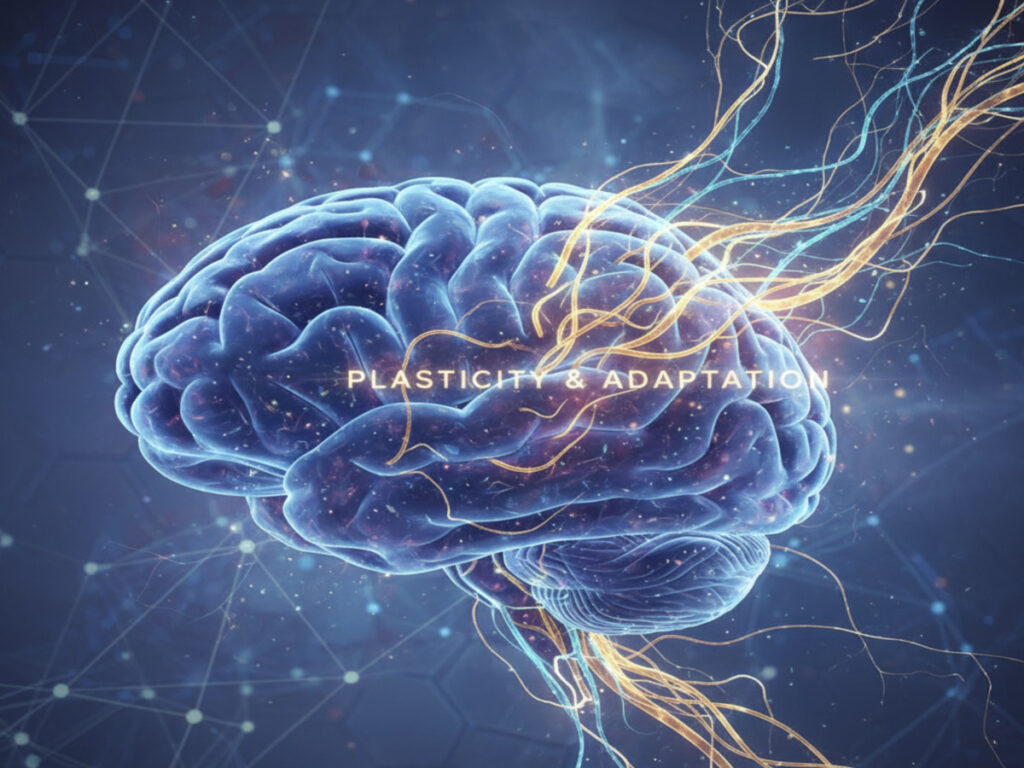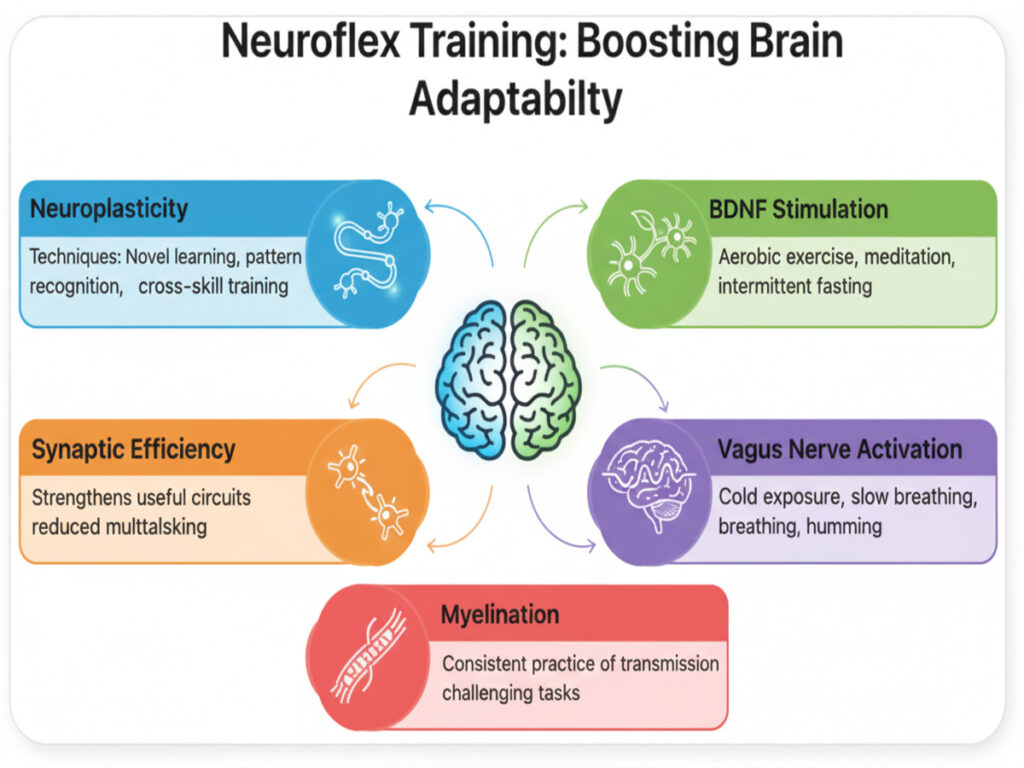Introduction: What Is Neuroflex Training?
Neuroflex Training is an emerging science-backed approach to enhancing cognitive flexibility, focus, and emotional stability through deliberate neural stimulation and behavioral conditioning.
Unlike traditional “brain games,” Neuroflex Training combines physical movement, breath regulation, mindfulness, and targeted learning protocols that promote neuroplasticity—the brain’s ability to rewire itself.
In 2025, as Americans face record levels of cognitive fatigue and digital overload, optimizing brain performance has evolved beyond supplements and meditation. Neuroflex Training provides a structured, evidence-driven way to train the brain for adaptability and lasting mental resilience.

The Neuroscience of Brain Flexibility
The foundation of Neuroflex Training lies in neuroplasticity—the brain’s capacity to form new neural connections in response to learning, stress, and experiences.
Key drivers include:
- BDNF (Brain-Derived Neurotrophic Factor): A protein that supports neuron growth, learning, and memory.
- Synaptic Pruning: The brain’s “clean-up” mechanism that removes inactive neural connections, improving efficiency.
- Myelination: The strengthening of neural pathways through repetition and focus.
A 2024 Harvard Medical School study found that structured neuroflex-style exercises increased BDNF levels by up to 35%, improving cognitive endurance and working memory.
Why Neuroflex Training Matters in 2025
Modern American lifestyles—dominated by screens, multitasking, and chronic stress—have weakened cognitive endurance.
According to the American Psychological Association, nearly 68% of adults report difficulty focusing due to digital distraction and mental overload.
Neuroflex Training offers a counterbalance: a practical system that combines neuroscience, mindfulness, and movement to retrain the brain for sustained attention and emotional equilibrium.
Core Benefits of Neuroflex Training
1. Cognitive Focus & Productivity
Neuroflex techniques help optimize prefrontal cortex activation, allowing for better executive control, planning, and sustained focus.
Practices such as alternating focus drills and controlled breathwork improve neural synchronization, making multitasking less cognitively expensive.
“The brain is like a muscle — without regular cognitive challenges and recovery cycles, it loses flexibility,”
says Dr. Laura Benton, Cognitive Neuroscientist at Johns Hopkins University.
2. Memory Enhancement
Neuroflex Training boosts working and long-term memory by strengthening hippocampal circuits through repetition, novelty, and active recall.
Combining spatial learning (movement-based memory) with cognitive exercises (pattern recognition) has shown to improve memory retention by up to 40% (National Institute on Aging, 2024).
3. Emotional Regulation & Resilience
Stress hijacks neural pathways, increasing reactivity. Neuroflex Training integrates breathing control, cold exposure, and mindfulness intervals, which enhance emotional resilience by calming the amygdala and activating the vagus nerve.
A 2025 Stanford study reported that individuals practicing neural-breathing and mindful exposure training had 25% faster stress recovery compared to control groups.
Key Mechanisms: Neuroplasticity, BDNF & Brain Rewiring
| Mechanism | Function | Training Technique |
|---|---|---|
| Neuroplasticity | Forms new neural pathways | Novel learning, pattern recognition, cross-skill training |
| BDNF Stimulation | Enhances neuron growth | Aerobic exercise, meditation, intermittent fasting |
| Synaptic Efficiency | Strengthens useful neural circuits | Deep focus work, reduced multitasking |
| Vagus Nerve Activation | Reduces anxiety and inflammation | Cold exposure, slow breathing, humming |
| Myelination | Improves neural transmission speed | Consistent practice of challenging tasks |

The 5 Pillars of Effective Neuroflex Training
- Neuro-Movement Integration – Combine physical motion (yoga, balance drills) with cognitive tasks.
- Focused Breathing Intervals – Use 4-7-8 or box breathing to enhance attention and calm.
- Cognitive Agility Drills – Alternate between mental and motor challenges to strengthen adaptability.
- Emotional Reset Techniques – Short mindfulness breaks, gratitude journaling, and reflective silence.
- Sleep & Recovery Alignment – Deep sleep promotes neural repair and consolidation.
“When mental training is paired with body movement, the brain’s adaptability skyrockets,”
notes Dr. Evan Ross, Neuroperformance Researcher at UCLA.
Actionable Daily Neuroflex Strategies
| Time | Activity | Purpose |
|---|---|---|
| Morning (10 min) | Alternate nostril breathing + light stretching | Activates both brain hemispheres |
| Midday (5 min) | 3 rounds of box breathing | Stabilizes focus and stress hormones |
| Afternoon (15 min) | Learn a new motor task (juggling, dance pattern) | Stimulates neuroplasticity |
| Evening (10 min) | Reflective journaling or memory recall exercise | Reinforces long-term retention |
Checklist for Daily Neuroflex Optimization
☐ 7–8 hours of sleep
☐ 10+ minutes of focused breathing
☐ At least one novel learning activity
☐ Daily physical movement
☐ 15 minutes of screen-free mindfulness
Brain-Optimizing Nutrition Table
| Nutrient | Function | Food Sources |
|---|---|---|
| Omega-3 Fatty Acids | Supports neuron structure | Salmon, walnuts, flaxseeds |
| Magnesium | Reduces stress reactivity | Leafy greens, pumpkin seeds |
| Polyphenols | Protects neurons from oxidative stress | Berries, green tea, cocoa |
| Choline | Essential for memory formation | Eggs, liver, soybeans |
| Curcumin | Promotes BDNF production | Turmeric, black pepper |

Expert Insights on Neuroflex Training
“The brain thrives on challenge and recovery cycles. Neuroflex protocols are redefining cognitive training in the wellness space,”
says Dr. Melissa Tan, Neurocognitive Health Specialist.
“By merging breath control, movement, and targeted learning, we can measurably enhance mental agility and emotional control,”
adds Dr. Aaron McKnight, Director of Applied Neuroscience, University of Texas.
Common Myths & FAQ
Q1: Is Neuroflex Training just meditation or brain games?
A: No. It’s a structured method combining cognitive, physical, and emotional exercises that rewire the brain holistically.
Q2: How soon can results appear?
A: Noticeable improvements in focus and stress regulation can appear within 2–3 weeks of consistent training.
Q3: Do I need special equipment?
A: No. Most Neuroflex methods rely on natural body movement, breathwork, and learning challenges.
Q4: Can Neuroflex Training help anxiety?
A: Yes. By activating the vagus nerve and improving emotional control, it supports anxiety reduction naturally.
Authoritative Resources
For deeper exploration of neuroplasticity and brain training science:
- National Institute of Neurological Disorders and Stroke (NINDS)
- Harvard Health Publishing – The Science of Neuroplasticity
- Stanford Medicine – Stress and Brain Rewiring
- American Psychological Association – Cognitive Resilience Research
Conclusion & Call-to-Action
Neuroflex Training is more than a trend — it’s the next frontier of mental performance and emotional resilience.
By integrating breath, movement, and cognitive challenges into daily routines, you can retrain your brain for focus, adaptability, and emotional control.
Start small: pick one new skill this week, pair it with mindful breathing, and stay consistent.
Within weeks, your brain will begin to rewire — sharper, calmer, and more resilient than ever.

